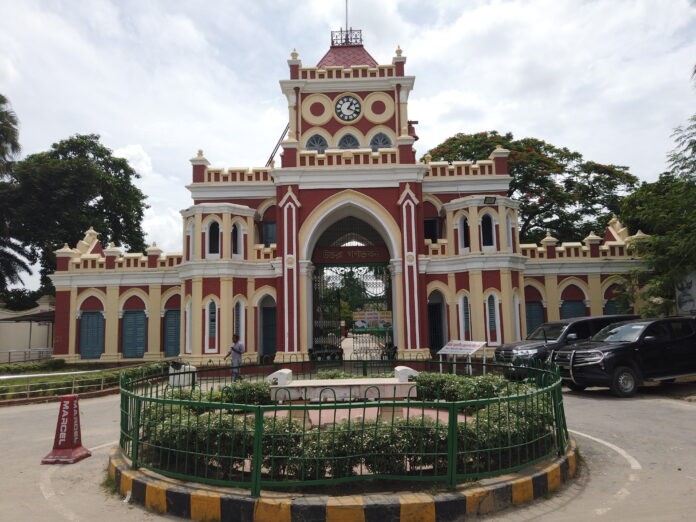Uttara Gonobhobon Natore is one of the famous place all over Bangladesh and outside of the country. It is the history of British period and the administration hall of North Bengal. The author of this place was the most powerful person in North Bengal. To know the history and the beautiful creation of that moment, you have to must come here.
Location:
It is located at the Natore district. It is only 3 km far from the Natore main city. You can reach there very easy by the car or bike. This complex is beside the highway. People all over the country can easily come here to see the beautiful scenery of this palace.
History:
Here has a vast history behind this beautiful work. The Natore dynasty originated in the early eighteenth century. Ganesh Roy and Bhabani Charan Chowdhury, zamindars of Bangachhi in Pargana, were dismissed in 1808 for failing to pay revenue. Dewan Raghunandan settled the zamindari in the name of his brother Ramjivan. Thus the Natore dynasty was founded. King Ramjivan was established as the first king of the Natore dynasty in 1806, in 1810. He died in 1834. In 1830, Rani Bhabani was married to Ramkant, the adopted son of Raja Ram Jiban.
After the death of King Rama, Ramakanta became the king of Natore. After the death of Raja Ramkant in 1848, Nawab Alivardi Khan entrusted the management of the zamindari to Rani Bhabani. During the reign of Rani Bhabani, her zamindari extended to present day Rajshahi, Pabna, Bogra, Kushtia, Jessore, Rangpur, Murshidabad, Birbhum and Malda districts of West Bengal.
According to historians, the Natore dynasty was originated in the eighteenth century. Among the zamindars of North Bengal, the king of Natore was foremost in value and property. Raja Ramjivan Roy was the founder of the Natore dynasty. Rambani’s adopted son Ramkant Roy was married to Bhabani, the only daughter of Atmaram Chowdhury of Chhatian village in Bogra district. Raja Ramjivan Roy died in 1630. Before his death, he appointed Ramkant Roy as king and Dewan Dayaram Roy as his guardian. Although Ramkanta was a king, Dayaram Roy actually ruled the entire kingdom. Due to his skill, the Natore dynasty prospered. King Ramkanta passed away in 1648. After the death of her husband, Rani Bhabani took over the management of the zamindari.
More Uttara Gonobhobon Natore
In the history of Natore, she is referred to as the philanthropic queen and her memory is still fresh. Rani Bhabani had cordial relations with the independent Nawab of Bengal, Siraj-ud-Daulah. Rani Bhabani was pleased with Naib Dayaram and gave him the gift of Dighapatiya Pargana. The present Uttara Ganobhaban at Dighapatiya was established during the reign of King Pramdanath, a descendant of Dayaram. During the reign of Pramdanath Roy, the sixth king of the dynasty, he convened a three-day session of the Bengal Provincial Congress on 10 June 1896 at Dompara ground in Natore. Many eminent persons including world poet Rabindranath Tagore joined the session as invited guests.
However, on the last day, 12 June 1897, when the palace was damaged by a devastating earthquake of about 17 minutes, Raja Pramodnath Roy rebuilt the entire palace complex. Raja Promodnath Roy built a total of 12 buildings, large and small, inside the palace surrounded by a boundary wall. He rebuilt the palace on 41 and a half acres of land with the help of foreign experts, engineers and painters and local craftsmen for 11 years from 1896 to 1908. He built this aesthetically pleasing royal palace with a mixture of Mughal and Western styles.
Over time, the palace became the Governor’s House first and later the Uttara Ganobhaban after the rise of Bangladesh, at the 9 February 1972, in that moment president of independence Bangladesh Sheikh Mujibor Rahman. Every prime minister of ruler of Bangladesh called the working meeting here. Now this historical place is under the Natore District administration.

Visiting Spots: Uttara Gonobhobon Natore
The full land area of this beautiful creation is totally loaded with beauty. You can see the many types of trees, which are too much old, specially mango trees. Here has various types of trees and flower plants. The main gate of this place is very beautiful, top of the main gate there has a clock, still now this clock showing right time. Time sound of the clock can be listened from very far. The sound system is time wise, if the time is 12am the clock sounds twelve times. Into the garden you can see the beautiful flower plants, canal around the whole area, this canal made for the protection and wall. Here have bath ghat beside the pond, byword here Rani Bhavani was bathed. In this pond have many bigger fishes. Beside this pond have a mini zoo. In this zoo you can see the deer.
Straight from the main gate you can see he cannon of war, some front you may see one two storey building, upper side of the building was the rest house of prince and ground floor was the jail. Behind this building you can see another building, here situated the collection house. You can go into the collection house and see the many historical things. Overall you can visit this place undoubtedly.
The total system of this place and natural view is too much impressive.
Entrance fee: Uttara Gonobhobon Natore
Entrance fee is 20 taka per head and if the number of person more than 50 and they area students some discounts available. If you’re visiting with bike there have garage for the parking and parking fee is 20 taka per motor bike. Into the palace here have a museum, the entrance fee for it 20 taka. You have to cut ticket from the main gate or you can cut ticket online also from the own website of Uttara Gonobhobon.
Opening time:
This is now under district administration. Opening time is everyday 9 am to 5 pm. In Ramadan month time is 9 am to 3 pm.
Natore is such a very beautiful district in Bangladesh. The behavior of the local people is very impressive. So wish you be safe and happy journey.
























